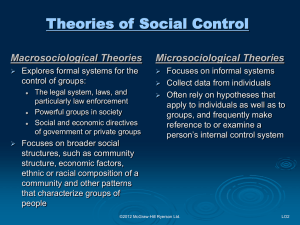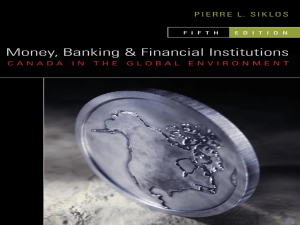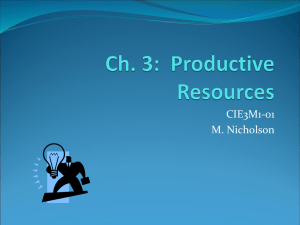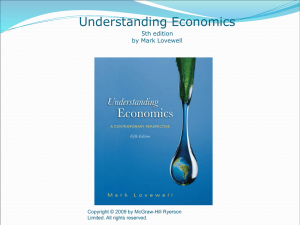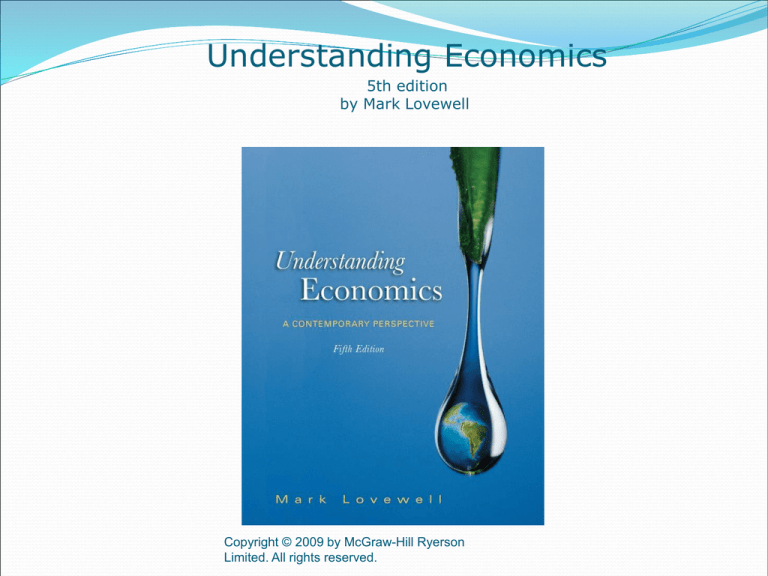
Understanding Economics
5th edition
by Mark Lovewell
Copyright © 2009 by McGraw-Hill Ryerson
Limited. All rights reserved.
Chapter 5
Perfect Competition
Copyright © 2009 by McGraw-Hill Ryerson Limited. All rights reserved.
Learning Objectives
After this chapter you will be able to:
distinguish the four market structures, and the main
differences among them
2. understand the profit-maximizing rule and how
perfect competitors use it in the short run
3. identify how perfect competitive markets adjust in the
long run, and the benefits they provide to consumers
1.
Copyright © 2009 by McGraw-Hill Ryerson
Limited. All rights reserved.
Market Structures
There are four main market structures:
perfect competition
monopolistic competition
oligopoly
monopoly
Copyright © 2009 by McGraw-Hill Ryerson
Limited. All rights reserved.
Perfect Competition
Perfectly competitive markets have three main
features:
many buyers and sellers
a standard product
easy entry and exit
Copyright © 2009 by McGraw-Hill Ryerson
Limited. All rights reserved.
Monopolistic Competition
Monopolistically competitive markets have three main
features:
many buyers and sellers
slightly different products
easy entry and exit
Copyright © 2009 by McGraw-Hill Ryerson
Limited. All rights reserved.
Oligopoly and Monopoly
In an oligopoly a few businesses (protected by entry
barriers) provide standard or similar products.
In a monopoly a single business (protected by entry
barriers) provides a product with no close substitutes.
Copyright © 2009 by McGraw-Hill Ryerson
Limited. All rights reserved.
Entry Barriers
There are six main entry barriers in oligopolies and
monopolies:
increasing returns to scale
market experience
restricted ownership of resources
legal obstacles (such as patents)
market abuses (such as predatory pricing)
advertising (which is most common in oligopolies)
Copyright © 2009 by McGraw-Hill Ryerson
Limited. All rights reserved.
Market Power
Market power:
is a business’s ability to affect the price it charges
varies with market structure, such that monopolists
have the most and perfect competitors have the least
Copyright © 2009 by McGraw-Hill Ryerson
Limited. All rights reserved.
Attributes of Market Structures
Figure 5.1, Page 119
Perfect
Competition
Monopolistic
Competition
Oligopoly
Monopoly
very many
many
few
one
Type of
Product
standard
differentiated
standard or
differentiated
not
applicable
Entry and Exit of
New Business
very easy
fairly easy
difficult
very
difficult
none
some
some
great
farming
restaurants
automobile
manufacturing
public
utilities
Numbers of
Businesses
Market Power
Example
Copyright © 2009 by McGraw-Hill Ryerson
Limited. All rights reserved.
Perfect Competitor’s Demand (a)
A perfect competitor has a demand curve different
from the market demand curve.
The business’s demand curve is horizontal at the
prevailing market price.
Copyright © 2009 by McGraw-Hill Ryerson
Limited. All rights reserved.
Perfect Competitor’s Demand (b)
Figure 5.2, page 121
Pure ‘n’ Simple T-Shirts’
Demand Curve
Market Demand and Supply
Curves for T-Shirts
6
Dm
0
Price ($ per T-Shirt)
Price ($ per T-Shirt)
Sm
27 000
Quantity of T-Shirts per Day
Copyright © 2009 by McGraw-Hill Ryerson
Limited. All rights reserved.
6
0
Quantity of T-Shirts per Day
Db
Average and Marginal Revenue
Total revenue is used to find two other revenue
concepts:
average revenue (total revenue divided by output)
marginal revenue (change in total revenue divided by
change in output)
Copyright © 2009 by McGraw-Hill Ryerson
Limited. All rights reserved.
Revenue Conditions for a Perfect
Competitor
Average revenue equals price, so that a perfect
competitor’s average revenue curve is its horizontal
demand curve.
A perfect competitor’s average revenue (price) is
constant so that marginal revenue and average revenue
are always equal.
Copyright © 2009 by McGraw-Hill Ryerson
Limited. All rights reserved.
Revenues for a Perfect Competitor
Price
(P)
($ per T-shirt)
$-6
6
6
6
6
Revenue Schedules for Pure ‘n’ Simple T-Shirts
Total Revenue Marginal Revenue
(TR)
(MR)
(P x q)
(ΔTR/Δq)
Quantity
(q)
(T-Shirts per day)
$ 0
80
200
250
270
280
$
0
480
1200
1500
1620
1680
Average Revenue
(AR)
(TR x q)
480/80 = $6
720/120 = 6
300/50 = 6
120/20 = 6
60/10 = 6
Revenue Curves for Pure ‘n’ Simple T-Shirts
$ per T-Shirt
Figure 5.3, page 122
6
Db = AR = MR
0
Quantity of T-Shirts per Day
Copyright © 2009 by McGraw-Hill Ryerson
Limited. All rights reserved.
480/80 = $6
1200/200 = 6
1500/250 = 6
1620/270 = 6
1680/280 = 6
The Profit-Maximizing Rule
The profit-maximizing rule states that profit is
maximized when marginal revenue equals marginal
cost. This means:
output should be increased if marginal revenue exceeds
marginal cost
output should be decreased if marginal cost exceeds
marginal revenue
Copyright © 2009 by McGraw-Hill Ryerson
Limited. All rights reserved.
Profit Maximization for a Perfect Competitor
Figure 5.4, page 124
Profit Maximization Table for Pure ‘n’ Simple T-Shirts
Total
Product
(q)
Price
(P)
(=AR)
0
80
200
250
270
280
$6
6
6
6
6
6
Marginal
Revenue
(MR)
Marginal
Average
Cost
Variable Cost
(MC)
(AVC)
(ΔTC/Δq)
(VC/q)
$6
6
6
6
6
$1.75
1.33
2.50
5.50
10.50
$1.75
1.50
1.70
1.98
2.29
Average
Cost
(AC)
(TC/q)
Total
Revenue
(TR)
$
$12.06
5.63
5.00
5.04
5.24
0
480
1200
1500
1620
1680
Total
Cost
(TC)
Total
Profit
(TR - TC)
$ 825
965
1125
1250
1360
1465
$-825
-485
75
250
260
215
Profit Maximization Graph for Pure ‘n’ Simple T-Shirts
MC
6.00
a
Db = MR = AR
Profit = $260
5.04
AC
$ per T-Shirt
b
AVC
0
270
Quantity of T-Shirts per Day
Copyright © 2009 by McGraw-Hill Ryerson
Limited. All rights reserved.
The Breakeven and Shutdown
Points
The breakeven point is where a business breaks even
while maximizing profit.
For a perfect competitor this occurs where price equals
minimum average cost.
The shutdown point is the lowest price at which a
business will choose to operate in the short run.
It occurs where price equals minimum average variable
cost.
Copyright © 2009 by McGraw-Hill Ryerson
Limited. All rights reserved.
A Perfect Competitor’s Supply
Curve
A perfect competitor’s supply curve is its marginal cost
curve above the shutdown point.
The market supply curve can be found by horizontally
adding the supply curves for all the businesses in the
industry.
Copyright © 2009 by McGraw-Hill Ryerson
Limited. All rights reserved.
Supply Curve for a Perfect
Competitor
Figure 5.5, page 126
Supply Curve for Pure ‘n’ Simple T-Shirts
Supply Schedule for
Pure ‘n’ Simple T-Shirts
($ per T-Shirt
$6.00
5.00
1.50
1.40
Quantity
Supplied
(q)
(T-Shirts per day)
270
250
200
0
a
6.00
$ per T-Shirt
Price
(P)
MC(=Sb)
5.00
b
MR1
AC
MR2
AVC
c
1.50
1.40
d
0
200
Quantity of T-Shirts per Day
Copyright © 2009 by McGraw-Hill Ryerson
Limited. All rights reserved.
250 270
Supply Curves for a Perfectly Competitive Business
and Market
Figure 5.6, page 127
Business and Market Supply Schedules for T-Shirts
Price
(P)
Quantity Supplied
(q)
(q)
(Sb)
(Sm)
(T-Shirts per day)
($ per T-Shirt)
$6.00
5.00
1.50
270
250
200
Supply Curve for T-Shirt Market
Sb
6.00
5.00
1.50
0
200
250 270
Price ($ per T-Shirt)
Price ($ per T-Shirt)
Supply Curve for
Pure ‘n’ Simply T-Shirts
27 000
25 000
20 000
Sm
6.00
5.00
1.50
0
Quantity of T-Shirts per Day
Copyright © 2009 by McGraw-Hill Ryerson
Limited. All rights reserved.
20 000 25 000 27 000
Quantity of T-Shirts per Day
Perfect Competition in the Long
Run
Entry and exit by businesses in the long run drives a
perfectly competitive market to the breakeven point.
Businesses enter markets where economic profits are
made so that supply shifts right and price falls.
Businesses leave markets where economic losses are
made so that supply shifts left and price rises.
Copyright © 2009 by McGraw-Hill Ryerson
Limited. All rights reserved.
Long-Run Equilibrium for a
Perfectly Competitive Business
Figure 5.7, page 129
Pure ‘n’ Simply T-Shirts
T-Shirt Market
MC
S0
6
b
a
5
MR
$ per T-Shirt
$ per T-Shirt
AC
S1
d
6
5
e
c
D0
0
250 270
Quantity of T-Shirts per Day
0
25 000 27 000 30 000
Quantity of T-Shirts per Day
Copyright © 2009 by McGraw-Hill Ryerson
Limited. All rights reserved.
D1
The Benefits of Perfect
Competition
Perfectly competitive markets in long-run equilibrium
meet two conditions that benefit consumers:
minimum-cost pricing (price = minimum average cost)
marginal-cost pricing (price = marginal cost)
Copyright © 2009 by McGraw-Hill Ryerson
Limited. All rights reserved.
How Resource Markets Operate
The demand for resources is based on the demand for
the products that these resources are used to produce.
According to marginal productivity theory, businesses
use resources based on how much extra profit each of
these resources provides.
Copyright © 2009 by McGraw-Hill Ryerson
Limited. All rights reserved.
The Demand for Resources
Three factors are important in determining the
demand for a resource:
a resource’s marginal cost
a resource’s marginal product
the marginal revenue of new units of output
Copyright © 2009 by McGraw-Hill Ryerson
Limited. All rights reserved.
A Product and Resource PriceTaker
If a business is a price-taker in its product and resource
markets:
the resource’s marginal cost is constant
the resource’s marginal product is variable
the marginal revenue of new units of output is constant
Copyright © 2009 by McGraw-Hill Ryerson
Limited. All rights reserved.
The Profit-Maximizing
Employment Rule
The profit-maximizing employment rule states that
profits are maximized when marginal revenue product
equals marginal resource cost.
Marginal revenue product is the change in total revenue
when employing a new unit of a resource.
Marginal resource cost is the change in total cost when
employing a new unit of a resource.
Copyright © 2009 by McGraw-Hill Ryerson
Limited. All rights reserved.
Labour Demand and Supply for a Product and
Resource Price-Taker
Figure A, Page 135
Labour Demand and Supply Schedules for a Strawberry Farm
Labour Total Product
(L)
(P)
(no. of
(q)
workers) (kilograms)
0
10
18
24
28
30
$2
2
2
2
2
2
10
8
6
4
2
Marginal
Marginal
Revenue
Resource Cost
Product
(MRC = W)
(MRP = ΔTR) ($ per hour)
$0
20
36
48
56
60
$20 (a)
16 (b)
12 (c)
8 (e)
4 (f)
Labour Demand and Supply Curves for a Strawberry Farm
Wage ($ per hour)
0
1
2
3
4
5
Marginal Product
Output Price
Total
(MP)
(P)
Revenue
(Δq/ΔL)
(TR)
(kilograms)
($ per kilogram) (P x q)
20
16
a
b
12
c
MRC = Sb
d
8
e
4
0
f
1
2
3
4
No. of Workers
Copyright © 2009 by McGraw-Hill Ryerson
Limited. All rights reserved.
MRP = Db
5
$10
10
10
> (d)
10
10
Market Demand and Supply
In a competitive labour market:
the market demand curve is found by horizontally
summing the labour demand curves for all businesses in
the industry
the market supply curve shows the total number of
workers offering their services in this industry at each
wage
Copyright © 2009 by McGraw-Hill Ryerson
Limited. All rights reserved.
Demand and Supply in a Competitive Labour Market
Figure B, Page 137
Labour Demand and Supply Curves
for Strawberry Farm Workers
Labour Demand and Supply Schedules
for Strawberry Farm Workers
$18
14
10
6
2
Labour Demanded
(DM)
(no. of
workers)
(farm)
(no. of
workers)
(market)
Labour
Supplied
(SM)
(no. of
workers)
(market)
1
2
3
4
5
1000
2000
3000
4000
5000
5000
4000
3000
2000
1000
SM
18
Wage ($ per hour)
Wage
(W)
($ per
hour)
14
10
e
6
2
0
DM
1000 2000 3000 4000 5000
No. of Workers
Copyright © 2009 by McGraw-Hill Ryerson
Limited. All rights reserved.
Demand for Other Resources
Marginal productivity theory is not always applicable
to other resources.
The theory can be employed for labour and for natural
resources, because these resources are measured in
standardized units.
It is harder to calculate marginal revenue product for
capital goods, because one investment project differs
from another.
Copyright © 2009 by McGraw-Hill Ryerson
Limited. All rights reserved.
Can Capitalism Survive?
Joseph Schumpeter:
believed that entrepreneurs are the driving force of
economic progress in capitalism
predicted that capitalism was doomed because of the
growing dominance of government bureaucracy
antagonistic to capitalism
Copyright © 2009 by McGraw-Hill Ryerson
Limited. All rights reserved.
Resource Demand (Online Learning Center)
A Product Price-Maker/ Resource Price-Taker (a)
If a business is a price-maker in its product market and
a price-taker in its resource market, then:
the resource’s marginal cost is constant
the resource’s marginal product varies
the marginal revenue of the new units of output falls as
quantity rises
Copyright © 2009 by McGraw-Hill Ryerson
Limited. All rights reserved.
Resource Demand (Online Learning Centre)
A Product Price-Maker/ Resource Price-Taker (b)
Just as in the case of a business that is a price-taker in
its product market, the profit-maximizing rule also
applies in this case of a product price-maker.
In other words, the business should use a resource up
to the point where its marginal revenue product and
its marginal revenue cost intersect.
Copyright © 2009 by McGraw-Hill Ryerson
Limited. All rights reserved.
Resource Demand (Online Learning Centre)
Labour Demand and Supply for a Product PriceMaker/Resource Price Taker Figure A
Labour Demand and Supply Curves
for Nirvana Cushions
Labour Demand and Supply Schedules
for Nirvana Cushions
0
1
2
3
4
Total
Marginal Output
Total
Product
Product
Price Revenue
(P)
(MP)
(P)
(TR)
(q)
(Δq/ΔL)
(P x q)
(no. of
(no. of
cushions) cushions)
0
4
7
9
10
4
3
2
1
$10
8
6
5
4
$0
32
42
45
40
Marginal
Revenue
Product
(MRP =
ΔTR/ ΔL)
$32 (g)
10 (h)
3 (j)
-5 (k)
Marginal
Resource
Cost
(MRC = W)
($ per hour)
$7
7
> (i)
7
7
Wage ($ per hour)
32
Labour
(L)
(no. of
workers)
g
h
10
7
3
0
-5
i
MRC = Sb
j
1
2
3
k4
5
MRP = Db
No. of Workers
Copyright © 2009 by McGraw-Hill Ryerson
Limited. All rights reserved.
Resource Demand (Online Learning Centre)
Market Demand and Supply
If the resource market this business is
operating in is competitive, the degree of
competition in the product does not affect
how market demand in the resource market
is determined.
As before (as shown in the text appendix),
the resource demand curves of all businesses
are combined to find the market demand
curve.
Copyright © 2009 by McGraw-Hill Ryerson
Limited. All rights reserved.
Resource Demand (Online Learning Centre)
Changes in Resource Demand (a)
There are three main resource demand
factors: product prices, resource prices, and
technological change.
Resource demand is affected by changes in
product prices. For example, a rise in a
product price causes the MRP for relevant
resources to rise, shifting demand for these
resources to the right.
Copyright © 2009 by McGraw-Hill Ryerson
Limited. All rights reserved.
Resource Demand (Online Learning Centre)
Changes in Resource Demand (b)
To identify the effect of other resources
prices, we must distinguish two types of
resource combinations.
Complementary resources are used together
(e.g. steam shovels and steam-shovel
operators). The price for one of these
resources and the demand for the other have
an inverse relationship. For example, a drop in
the price of steam shovels increases the
demand for steam shovel operators.
Copyright © 2009 by McGraw-Hill Ryerson
Limited. All rights reserved.
Resource Demand (Online Learning Centre)
Changes in Resource Demand (c)
Substitute resource are used in place of one
another (e.g. steam shovels and manual
labour). The price for one of these resources
and the demand for the other have a direct
relationship. For example, a drop in the price
of steam shovels decreases the demand for
manual labour.
Copyright © 2009 by McGraw-Hill Ryerson
Limited. All rights reserved.
Resource Demand (Online Learning Centre)
Changes in Resource Demand (d)
Technological innovation has two possible
effects. If a new or more productive type of
machine is introduced, for example,
complementary resources will increase in
demand, while demand for substitute
resources will decrease.
Copyright © 2009 by McGraw-Hill Ryerson
Limited. All rights reserved.
The Ethics of Exchange (a)
(Online Learning Centre)
The ancient philosopher Aristotle:
stated that trade should be based on an ‘equality of
proportion’ between the two items being exchanged
was the first to point out the potential injustices caused
by monopoly power
Copyright © 2009 by McGraw-Hill Ryerson
Limited. All rights reserved.
The Ethics of Exchange (b)
(Online Learning Centre)
Aristotle distinguished two types of value:
Use value relates to a good’s intrinsic characteristics.
Exchange value relates to how much a good can fetch in
return for other goods.
Aristotle saw these values as distinct, based on the socalled paradox of value, whereby some rare goods such
as gold are worth more than useful goods such as iron.
Copyright © 2009 by McGraw-Hill Ryerson
Limited. All rights reserved.
The Ethics of Exchange (c)
(Online Learning Centre)
According to Aristotle and his followers (both
historical and present-day), a overemphasis on the
exchange values of products diminishes our ability to
recognize real worth.
Copyright © 2009 by McGraw-Hill Ryerson
Limited. All rights reserved.
Chapter 5
The End
Copyright © 2009 by McGraw-Hill Ryerson Limited. All rights reserved.



